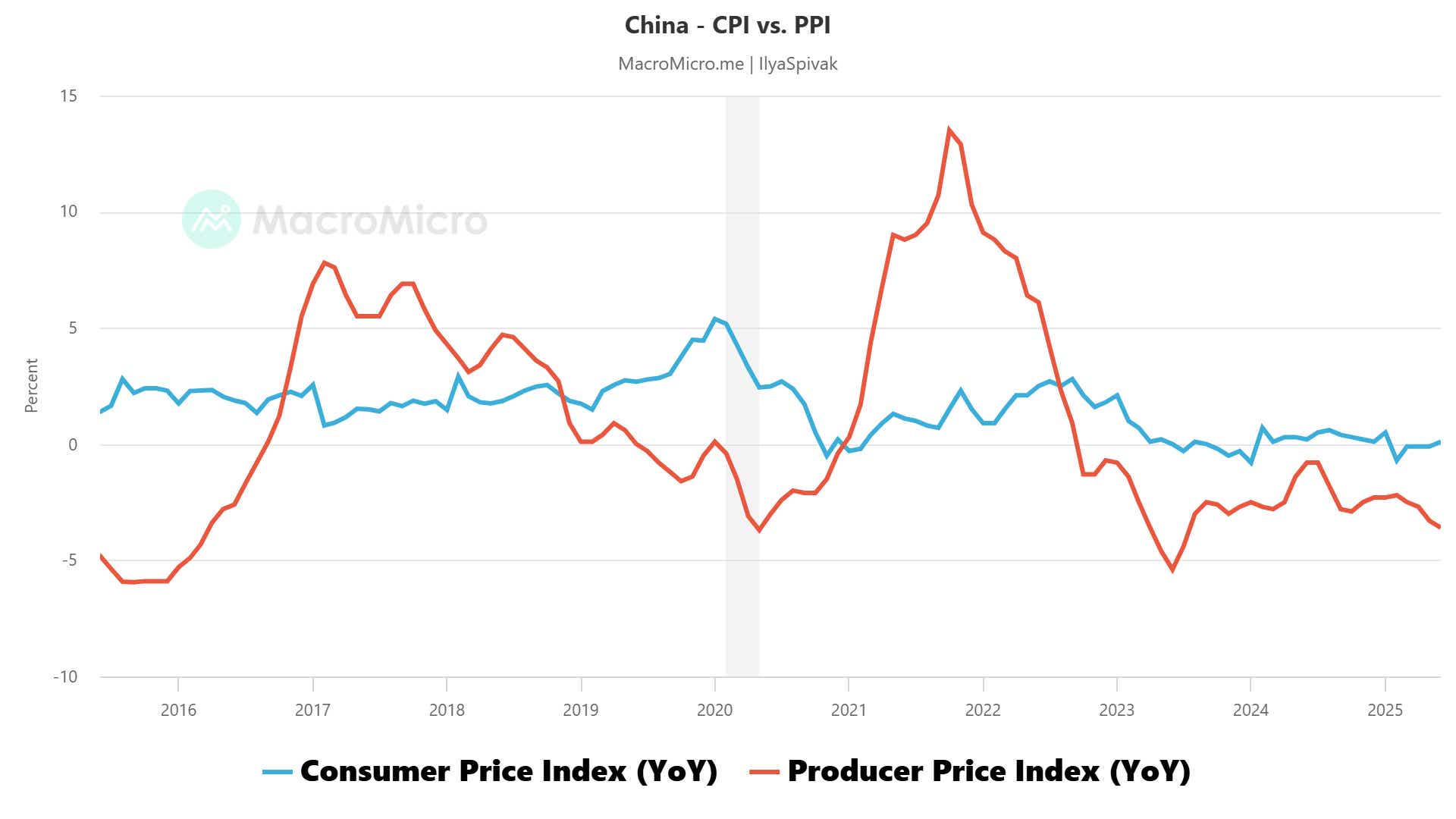China is Too Weak to Save Global Growth if the US Economy Missteps

China is Too Weak to Save Global Growth if the US Economy Missteps
By:Ilya Spivak
China’s sickly economy leaves the US to carry global growth and defend against recession
- China’s inflation data still points to anemic demand, despite a limp uptick.
- Soggy results may be ahead for incoming trade and economic growth data.
- The US remains the single point of failure keeping global recession at bay.
Another soggy set of inflation figures from China suggests the world’s second-largest economy remains in the doldrums. The consumer price index (CPI) rose 0.1% year-on-year June, marking the first annualized increase in prices since January. Economists expected a flat result ahead of the release.
However, CPI fell 0.1% from the prior month, marking the second consecutive drop and the fourth month in negative territory so far this year. In level terms, CPI has idled in stubborn one-percent oscillation range for over two years, making the positive year-on-year reading appear more like mean reversion than the start of a rebound.
Inflation data paints a bleak picture of the economy in China
Producer price index (PPI) data pointed to deeper wholesale deflation. A drop of 3.6% year-on-year exceeded expectations for a fall of 3.2% and marked the fastest decline since July 2023. In terms of pacing, a monthly drop of 0.4% matched the preceding three months.

These figures hint that the burst of activity from frontrunning higher US tariffs at the start of the year is cooling, while domestic demand remains anemic. Twin sets of purchasing managers index (PMI) data released last week – an official one and a private-sector version from S&P Global – had economic activity growth hovering only a touch above standstill.
Incoming trade figures will mark the next chapter in the monthly economic data roundup. Recent trends here have been disappointing. Export growth has cooled for two consecutive months after a jump in March while imports have fallen every month so far this year.
The US stands alone between the global economy and recession
That makes for an ominous backdrop ahead of the release of China’s second-quarter Gross Domestic Product (GDP) numbers next week. Those figures have shown real GDP growth outpacing nominal expansion for eight consecutive quarters, implying two years of economy-wide deflation.
.png?format=pjpg&auto=webp&quality=50&width=1920&disable=upscale)
Put simply, this means that demand is woefully weak relative to supply, putting the whole of China’s economy on discount. That is a dismal state of affairs for global growth at large. China long with the US and the Eurozone account for 58% of worldwide GDP. With China limping along and Europe at near-standstill, the US is the only game in town.
That is a dangerous configuration at a time when US economic data seems to be cooling, the bond market reveals priced-in inflation expectations have been cooling since the beginning of the year, and Fed Funds futures point to more rate cuts than the central bank expects. If US growth buckles downwind, the global economy has no safety net.
Ilya Spivak, tastylive head of global macro, has 15 years of experience in trading strategy, and he specializes in identifying thematic moves in currencies, commodities, interest rates and equities. He hosts #Macro Money and co-hosts Overtime, Monday-Thursday. @Ilyaspivak
For live daily programming, market news and commentary, visit #tastylive or the YouTube channels tastylive (for options traders), and tastyliveTrending for stocks, futures, forex & macro.
Trade with a better broker, open a tastytrade account today. tastylive, Inc. and tastytrade, Inc. are separate but affiliated companies.
Options involve risk and are not suitable for all investors. Please read Characteristics and Risks of Standardized Options before deciding to invest in options.
tastylive content is created, produced, and provided solely by tastylive, Inc. (“tastylive”) and is for informational and educational purposes only. It is not, nor is it intended to be, trading or investment advice or a recommendation that any security, futures contract, digital asset, other product, transaction, or investment strategy is suitable for any person. Trading securities, futures products, and digital assets involve risk and may result in a loss greater than the original amount invested. tastylive, through its content, financial programming or otherwise, does not provide investment or financial advice or make investment recommendations. Investment information provided may not be appropriate for all investors and is provided without respect to individual investor financial sophistication, financial situation, investing time horizon or risk tolerance. tastylive is not in the business of transacting securities trades, nor does it direct client commodity accounts or give commodity trading advice tailored to any particular client’s situation or investment objectives. Supporting documentation for any claims (including claims made on behalf of options programs), comparisons, statistics, or other technical data, if applicable, will be supplied upon request. tastylive is not a licensed financial adviser, registered investment adviser, or a registered broker-dealer. Options, futures, and futures options are not suitable for all investors. Prior to trading securities, options, futures, or futures options, please read the applicable risk disclosures, including, but not limited to, the Characteristics and Risks of Standardized Options Disclosure and the Futures and Exchange-Traded Options Risk Disclosure found on tastytrade.com/disclosures.
tastytrade, Inc. ("tastytrade”) is a registered broker-dealer and member of FINRA, NFA, and SIPC. tastytrade was previously known as tastyworks, Inc. (“tastyworks”). tastytrade offers self-directed brokerage accounts to its customers. tastytrade does not give financial or trading advice, nor does it make investment recommendations. You alone are responsible for making your investment and trading decisions and for evaluating the merits and risks associated with the use of tastytrade’s systems, services or products. tastytrade is a wholly-owned subsidiary of tastylive, Inc.
tastytrade has entered into a Marketing Agreement with tastylive (“Marketing Agent”) whereby tastytrade pays compensation to Marketing Agent to recommend tastytrade’s brokerage services. The existence of this Marketing Agreement should not be deemed as an endorsement or recommendation of Marketing Agent by tastytrade. tastytrade and Marketing Agent are separate entities with their own products and services. tastylive is the parent company of tastytrade.
tastyfx, LLC (“tastyfx”) is a Commodity Futures Trading Commission (“CFTC”) registered Retail Foreign Exchange Dealer (RFED) and Introducing Broker (IB) and Forex Dealer Member (FDM) of the National Futures Association (“NFA”) (NFA ID 0509630). Leveraged trading in foreign currency or off-exchange products on margin carries significant risk and may not be suitable for all investors. We advise you to carefully consider whether trading is appropriate for you based on your personal circumstances as you may lose more than you invest.
tastycrypto is provided solely by tasty Software Solutions, LLC. tasty Software Solutions, LLC is a separate but affiliate company of tastylive, Inc. Neither tastylive nor any of its affiliates are responsible for the products or services provided by tasty Software Solutions, LLC. Cryptocurrency trading is not suitable for all investors due to the number of risks involved. The value of any cryptocurrency, including digital assets pegged to fiat currency, commodities, or any other asset, may go to zero.
© copyright 2013 - 2025 tastylive, Inc. All Rights Reserved. Applicable portions of the Terms of Use on tastylive.com apply. Reproduction, adaptation, distribution, public display, exhibition for profit, or storage in any electronic storage media in whole or in part is prohibited under penalty of law, provided that you may download tastylive’s podcasts as necessary to view for personal use. tastylive was previously known as tastytrade, Inc. tastylive is a trademark/servicemark owned by tastylive, Inc.